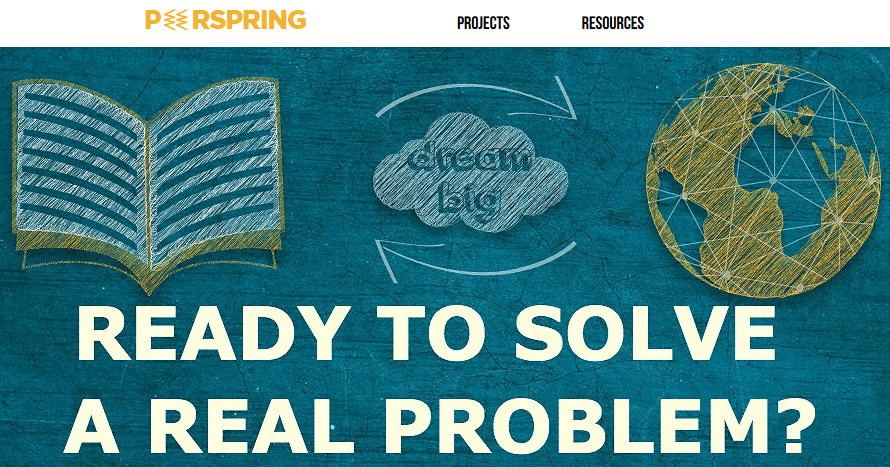 Sept. 19, 2016 When media pundits paint with a large brush focusing on “youth narcissism and selfie culture” amidst passionistas and purposeful prosocial projects that amplify student voice, it’s beyond irksome, it’s glaringly inaccurate.
Sept. 19, 2016 When media pundits paint with a large brush focusing on “youth narcissism and selfie culture” amidst passionistas and purposeful prosocial projects that amplify student voice, it’s beyond irksome, it’s glaringly inaccurate.
Our friends at PeerSpring host an entire platform brimming with youth change agents making their mark with projects important to them, from 11-year old Marley Dias calling attention to representation in children’s literature with her #1000BlackGirlBooks hashtag, to countless social innovation and teen entrepreneurial ventures spanning STEM to seeding nature, social media has turned up the volume to a roar.
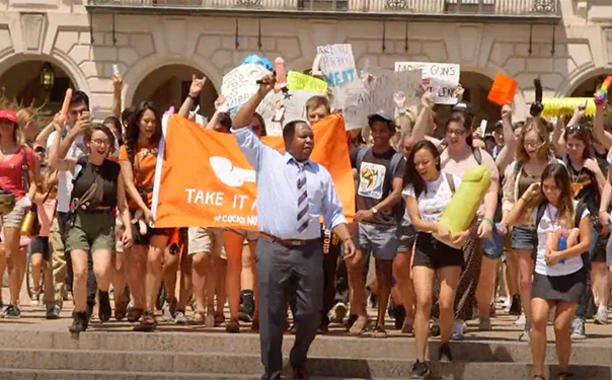 Media now seems to be paying more attention to youth concerns…
Media now seems to be paying more attention to youth concerns…
Whether it’s this week’s Guardian article about young musicians “making music that tackle the big social issues of the day” or Comedy Central’s The Daily Show visiting UT Austin to showcase the sex toys vs guns protests challenging “Open Carry” policies on college campuses with the edgy “C*cks not Glocks” slogan.
Watch closely as marketers scramble for mindshare…Will educators begin hand-wringing about unwanted spotlights on their schools? Will parents fear digital tattoos of teens labeled with the loaded term “activist” or will it all become a leadership style, or even a new part of personal branding?
Long gone are the days when kids were “seen and not heard,” students using social media are able to rally their peers around causes that matter, and amplify to a high decibel level.
The timing is ripe for a 2016 Field Guide to help build media literate leaders, ready to confront systemic strife. More than a ‘how-to’ guide, Lyn Mikel Brown’s new book Powered by Girl shares pragmatic tips to channel passion productively across generations. Moreover, it’s packed with hands-on, candid examples of what worked, what fell flat and why…
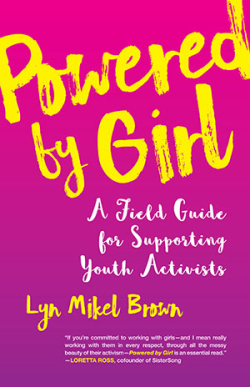
Powered by Girl reminds that we don’t necessarily need a ‘study’ to validate the obvious merits of leveraging youth passion as a leadership tool.
It’s intuitive if you’re truly listening…obvious if you’re one of us doing work for a decade in this realm. That said, quantifiable data DOES help support the work…so when the New York Times wrote this week about youth embracing healthier behavior as an act of rebellion, albeit in a cynical headline, “Can Teenage Defiance Be Manipulated for Good?” it gave me pause…
…Partly because this is applied science that we use daily with Shaping Youth media literacy to ‘lift and reveal’ various agendas…and partly because I’ve never seen it as ‘manipulation’ but rather as triggering critical consciousness and even behavior change that inspires youth to lead with their own voice stirring action!
Lyn’s new book offers case by case of this applied science to help adult supports attempting to “engage youth” get it right…Repeat after me:
Youth lead when motivated by their own agendas NOT those of adults…
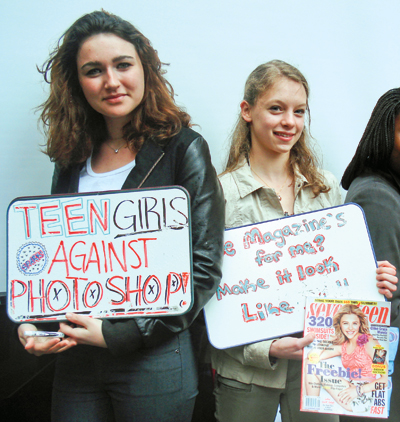
The nuanced, important case studies within Powered by Girl are the hands-on tip sheets we need to fully understand how behavior change works, and also points to why so many nonprofits and well-meaning public health programs fail miserably, spending so much time trying to “teach” rather than “reach” youth.
Our role is to seed inquiry and explore the evidence once youth have asked…because then THEIR ideas come to the forefront, they own the conversation, and the change-making takes hold with peer to peer authenticity and grassroots leadership rather than a canned, mass produced guerilla marketing campaign.
Today, author Lyn Mikel Brown expands on ways to scale these vibrant voices and youth-led visions to help maximize efforts while staying out of their way. It’s must read media for anyone working alongside youth that endeavor to be more than a ‘personal branding’ vanity effort of fluff-n-stuff. Enjoy!
Shaping Youth In Conversation with
Powered by Girl Author Lyn Mikel Brown
Amy Jussel, Shaping Youth What media platform do you see teens/youth using most w/their advocacy for change? Could you take us through the scaling and amplification of a project w/best practices?
Author Lyn Mikel Brown, Powered by Girl: I think digital diversity is key to the SPARK team’s success. They use the platforms that allow them to do what they need to do. It’s a very creative process and shifts from campaign to campaign. When the team pushed Google to diversify their Doodles, they used conferencing platforms like Zoom and Google Hangout to plan with staff adults Dana Edell, SPARK’s ED, and Programming coordinator, Melissa Campbell. Like all of SPARK’s actions, adults offered guidance and support, but the campaign was girl-driven.
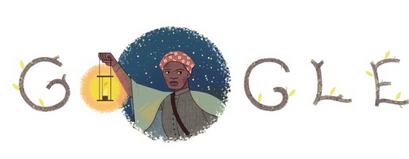 The girls conducted research to assess the scope of the problem, analyzing the Google Doodles by gender and race. They created a report complete with bar graphs and pie charts and research analysis. They blogged about the results and their concerns and created a petition on Change.org asking Google to include more women and people of color. They developed a really compelling Doodle Us! video that conveyed why it mattered that girls and especially girls of color see themselves reflected in the Doodles, and then they created a Tumblr page inviting others to submit historical figures they thought should be featured as a Google Doodle.
The girls conducted research to assess the scope of the problem, analyzing the Google Doodles by gender and race. They created a report complete with bar graphs and pie charts and research analysis. They blogged about the results and their concerns and created a petition on Change.org asking Google to include more women and people of color. They developed a really compelling Doodle Us! video that conveyed why it mattered that girls and especially girls of color see themselves reflected in the Doodles, and then they created a Tumblr page inviting others to submit historical figures they thought should be featured as a Google Doodle.
All along, they pushed out the campaign on Facebook, Twitter, Tumblr, Instagram, Youtube, on every platform they use. Other campaigns might be almost entirely on Tumblr or Twitter. The girls decide as they build the action.
Amy Jussel, Shaping Youth For mentoring models, can you cite best practices for how to scale a local project into a larger lens to be replicated elsewhere or scaled via social media with visual insights?
Lyn Mikel Brown, Powered by Girl: Developing an intergenerational campaign that’s truly girl-fueled means adults offer advice and support and girls make key decisions. As adults we have to let go of our need for control over what girls decide to do with what we offer.
Adults often have perspectives and experiences and skills that are useful at the front end, when we’re discussing the problem, it’s root causes, and especially if understanding the problem requires research and the girls need to learn how to write a survey or do data analysis. But youth are so much more attuned to how a problem impacts youth, and so it’s vital to see them as the experts on their own experience.
As adults, we need to be especially aware of our impulse to take over or our tendency to override girls’ voices because “we know better.” I think what makes an action or project take off has more to do with how it sits with girls, how it connects with or resonates with their experiences.
Photoshop is something all girls deal with in their magazines, so SPARK’s challenge to Seventeen to give up photoshop resonated. Girls everywhere could write to the magazine or sign the petition.
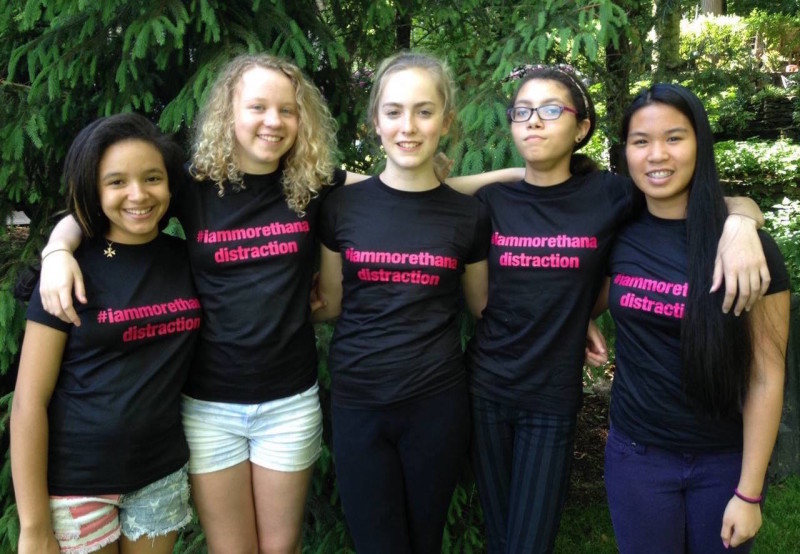 A great example is #IAmMoreThanADistraction and how it’s been used to connect girls doing local school dress code protests.
A great example is #IAmMoreThanADistraction and how it’s been used to connect girls doing local school dress code protests.
Girls share this hashtag with their protests, but it’s also a concise summary of the problem they share. It now stands for all the ways girls are objectified and sexualized in schools and the ways school dress code policies enable such treatment. It’s ingenious. It has served to connect girls around a common problem and increase awareness as well as shore up support for local protests.
Amy Jussel, Shaping Youth What’s been your team’s most successful large scale intergenerational action visibility wise and when/where was media best used to amplify youth voices?
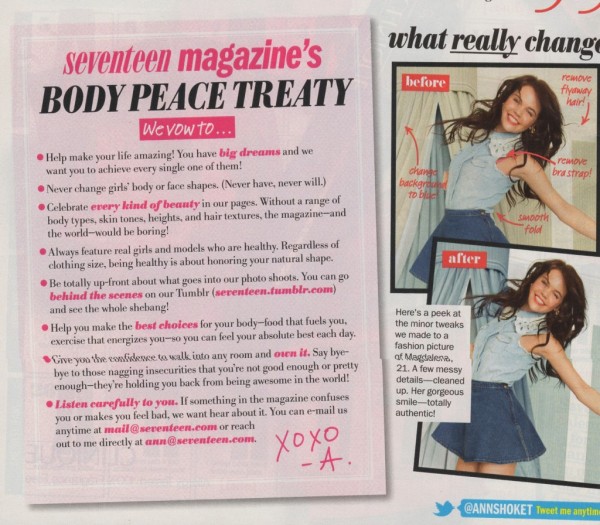 Lyn Mikel Brown, Powered by Girl: Our Seventeen Magazine action, for sure.
Lyn Mikel Brown, Powered by Girl: Our Seventeen Magazine action, for sure.
Again we used a petition on Change.org. Julia and Izzy made a video of girls and boys in their school critiquing images of ads and models in Seventeen and the team blogged and shared the action with our sister orgs and via their personal social media accounts. The scale of that action really surprised us and taught us a lot about timing.
We launched the action during public controversy about too-young models and too-thin models, and at a time when France and England were considering nonphotoshop policies. This helped us generate media attention—although as I explain in the book, the story journalists told was partial—they were less interested in our intergenerational campaign and more interested in highlighting how amazing one or two of the girls were. But the petition went viral.
When the team developed the idea to protest outside of Seventeen Headquarters, we connected with the press beforehand to let them know. Here’s where adult skills and connections can really help girls move actions forward. SPARK adults offered space for the girls to work and helped with travel to the action. Shelby Knox shared media contacts with us and Jamia Wilson, then at the Women’s Media Center, met with the girls to prepare them to talk with media at the event.
Amy Jussel, Shaping Youth Name some pros/cons of partnering with other organizations to scale a message…
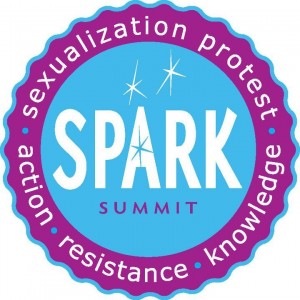 Lyn Mikel Brown, Powered by Girl: From the very beginning SPARK Movement worked to develop a committed group of partners from across the country, mostly small grassroots girl-serving organizations. As you know—because you were there!–We launched SPARK with a summit and invited these organizations to participate—to bring their girls, to take part in panels and actions spots, and events.
Lyn Mikel Brown, Powered by Girl: From the very beginning SPARK Movement worked to develop a committed group of partners from across the country, mostly small grassroots girl-serving organizations. As you know—because you were there!–We launched SPARK with a summit and invited these organizations to participate—to bring their girls, to take part in panels and actions spots, and events.
People were energized and committed to the work and the process and willing to share our actions with their followers.
That’s key with partner orgs—doing the kind of upfront work that connects people and engages them. When our actions went live, we reached out to these organizations for help spreading the word and they came through because they had a sense of ownership.
BUT, it’s a lot of work to keep partner orgs engaged and involved so that they participate in an ongoing and active way. Small orgs have few staff and little money and we’re asking them to do something that might not benefit them in the moment and that takes time from busy schedules. So unless we can continuously reach out and clearly make a case for why participation benefits them, it’s hard to sustain the energy and the coalition.
Amy Jussel, Shaping Youth How do brands factor into youth advocacy, and which ones have youth pointed towards in their lens of what’s ‘worked’ for them? (e.g. Always/Like A Girl? etc.)
Lyn Mikel Brown, Powered by Girl: Girls sometimes blog about a cool marketing campaign, but not always in support. Because we worked a lot on media literacy with the team, they were all over marketing contradictions—like the fact that Dove still promoted a focus on individual beauty, that their parent company Unilever sold Axe products in sexist ways to boys, and sold racist skin lightening creams in India.
 I think of brands like Miss Representation in a slightly different way. As an organization we often partnered with other orgs we shared feminist values with to promote campaigns, like Miss Rep’s #NotBuyingIt or the National Eating Disorder Association’s Proud2Bme campaign or the Brave Girls Want collective’s push for more responsible marketing to girls. So at various times we would launch campaigns together to support and leverage one another’s brands for the common good.
I think of brands like Miss Representation in a slightly different way. As an organization we often partnered with other orgs we shared feminist values with to promote campaigns, like Miss Rep’s #NotBuyingIt or the National Eating Disorder Association’s Proud2Bme campaign or the Brave Girls Want collective’s push for more responsible marketing to girls. So at various times we would launch campaigns together to support and leverage one another’s brands for the common good.
Amy Jussel, Shaping Youth What’s one of your favorite lessons from one of your moments working with the girls that didn’t make the book?
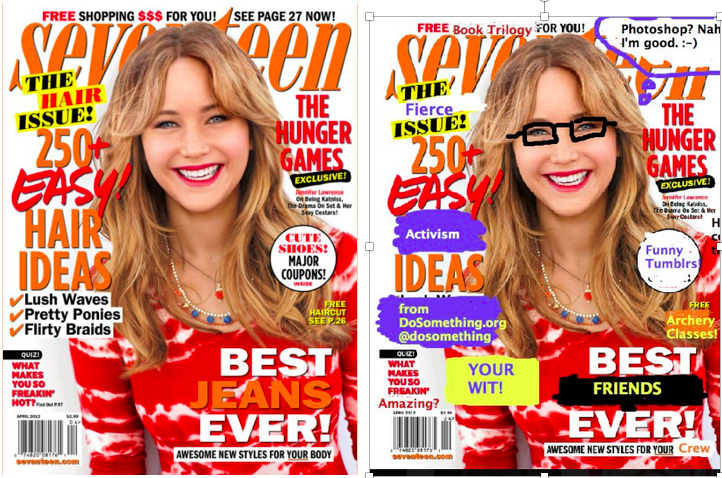 Lyn Mikel Brown, Powered by Girl: For a while we had a culture jamming app on the Powered By Girl blogging site—a drawing and coloring app that allowed people to remake ads and magazine covers in ways that revealed the underlying sexism or racism or homophobia. And we had a weekly contest inviting girls to remake an ad; we would choose the winner at the end of the week and move it around social media.
Lyn Mikel Brown, Powered by Girl: For a while we had a culture jamming app on the Powered By Girl blogging site—a drawing and coloring app that allowed people to remake ads and magazine covers in ways that revealed the underlying sexism or racism or homophobia. And we had a weekly contest inviting girls to remake an ad; we would choose the winner at the end of the week and move it around social media.
Girls were brilliant at this and people loved them. They were hilarious parodies and cleverly ironic, but it was like pulling teeth to get girls to actually submit each week.
Eventually we let it go—we just didn’t have the funds to pay someone to do outreach and share the contest. I guess the message for me was:
“If you build it, they won’t necessarily come.” It can be great, people can love it, but if it’s not where girls are at, if it’s not quick enough or doesn’t pull them in, it’s not happening.
…But when I see things like the recently remade Girls Life cover circulating on social media, I think of Powered by Girl and I think we did have an influence.
Amy Jussel, Shaping Youth Without a doubt, your Powered by Girl organization sparked change way back then contributing to the type of culture jamming making headlines today. Honored to have been a part of some of these movements over the last half dozen years.
I’ve learned a lot about media savvy movements and what listening/learning and mutual growth truly means…Changing the channel of influence is one thing; I now know how important it is to have youth switch the track on a runaway train, and how and when to get the heck outta the way.
One of SPARK movement’s youth-led actions:
Diversity in Google Doodles
SPARKing Change Beyond the TEDification of Teen Discourse
Visual Credits: Comedy Central (UT Austin protest via Entertainment Weekly) NEA Today for #IAmMoreThanADistraction photo, Screenshots via the Spark Movement and Lyn Mikel Brown








With technology and social media, raising kids into impressionable teenagers is not easy. But I’m glad my kids are doing fine.